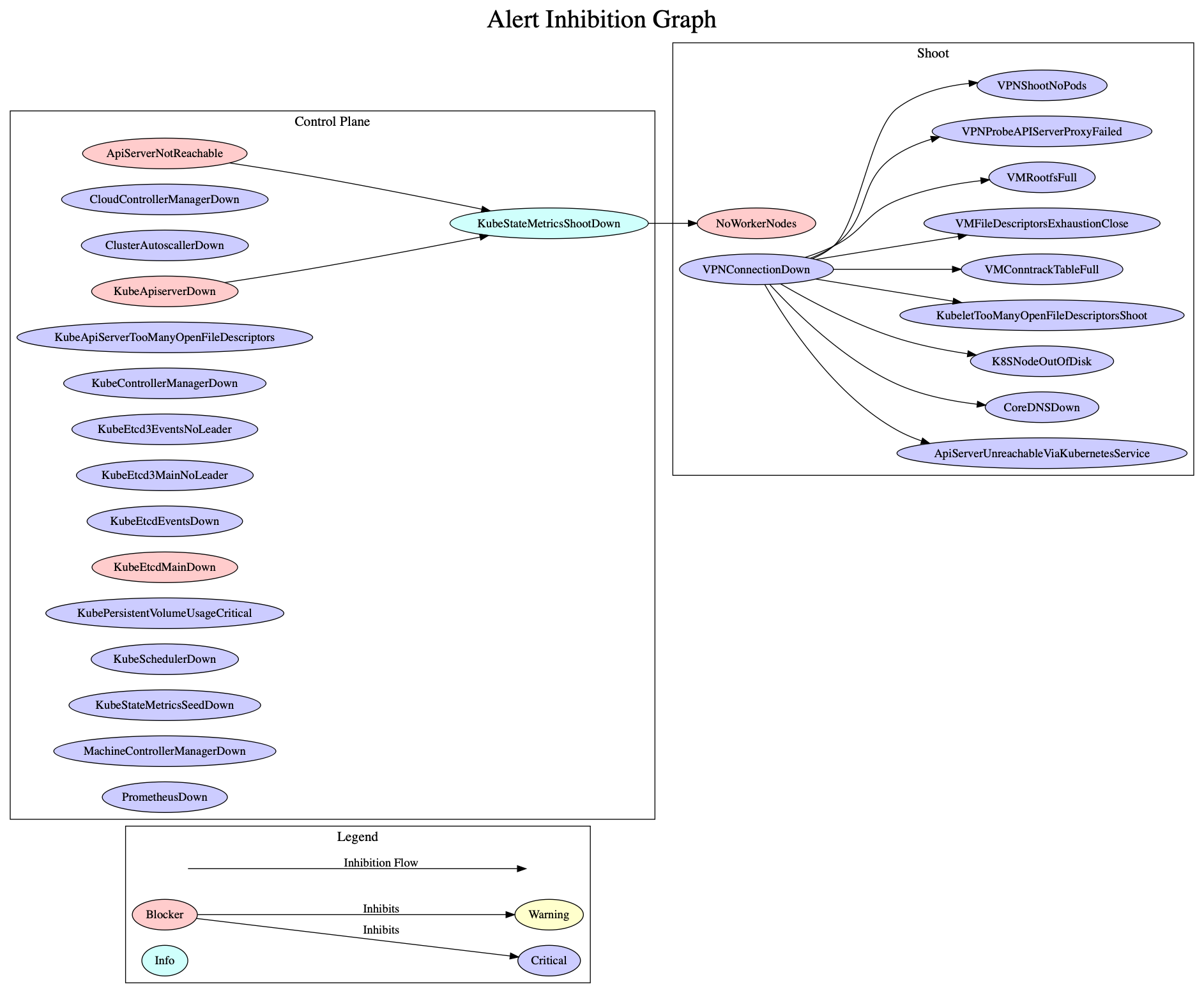Alerting
Gardener uses Prometheus to gather metrics from each component. A Prometheus is deployed in each shoot control plane (on the seed) which is responsible for gathering control plane and cluster metrics. Prometheus can be configured to fire alerts based on these metrics and send them to an Alertmanager. The Alertmanager is responsible for sending the alerts to users and operators. This document describes how to setup alerting for:
Alerting for Users
To receive email alerts as a user, set the following values in the shoot spec:
spec:
monitoring:
alerting:
emailReceivers:
- john.doe@example.comemailReceivers is a list of emails that will receive alerts if something is wrong with the shoot cluster.
Alerting for Operators
Currently, Gardener supports two options for alerting:
Email Alerting
Gardener provides the option to deploy an Alertmanager into each seed. This Alertmanager is responsible for sending out alerts to operators for each shoot cluster in the seed. Only email alerts are supported by the Alertmanager managed by Gardener. This is configurable by setting the Gardener controller manager configuration values alerting. See Gardener Configuration and Usage on how to configure the Gardener's SMTP secret. If the values are set, a secret with the label gardener.cloud/role: alerting will be created in the garden namespace of the garden cluster. This secret will be used by each Alertmanager in each seed.
External Alertmanager
The Alertmanager supports different kinds of alerting configurations. The Alertmanager provided by Gardener only supports email alerts. If email is not sufficient, then alerts can be sent to an external Alertmanager. Prometheus will send alerts to a URL and then alerts will be handled by the external Alertmanager. This external Alertmanager is operated and configured by the operator (i.e. Gardener does not configure or deploy this Alertmanager). To configure sending alerts to an external Alertmanager, create a secret in the virtual garden cluster in the garden namespace with the label: gardener.cloud/role: alerting. This secret needs to contain a URL to the external Alertmanager and information regarding authentication. Supported authentication types are:
- No Authentication (none)
- Basic Authentication (basic)
- Mutual TLS (certificate)
Remote Alertmanager Examples
Note: The
urlvalue cannot be prepended withhttporhttps.
# No Authentication
apiVersion: v1
kind: Secret
metadata:
labels:
gardener.cloud/role: alerting
name: alerting-auth
namespace: garden
data:
# No Authentication
auth_type: base64(none)
url: base64(external.alertmanager.foo)
# Basic Auth
auth_type: base64(basic)
url: base64(external.alertmanager.foo)
username: base64(admin)
password: base64(password)
# Mutual TLS
auth_type: base64(certificate)
url: base64(external.alertmanager.foo)
ca.crt: base64(ca)
tls.crt: base64(certificate)
tls.key: base64(key)
insecure_skip_verify: base64(false)
# Email Alerts (internal alertmanager)
auth_type: base64(smtp)
auth_identity: base64(internal.alertmanager.auth_identity)
auth_password: base64(internal.alertmanager.auth_password)
auth_username: base64(internal.alertmanager.auth_username)
from: base64(internal.alertmanager.from)
smarthost: base64(internal.alertmanager.smarthost)
to: base64(internal.alertmanager.to)
type: OpaqueConfiguring Your External Alertmanager
Please refer to the Alertmanager documentation on how to configure an Alertmanager.
We recommend you use at least the following inhibition rules in your Alertmanager configuration to prevent excessive alerts:
inhibit_rules:
# Apply inhibition if the alert name is the same.
- source_match:
severity: critical
target_match:
severity: warning
equal: ['alertname', 'service', 'cluster']
# Stop all alerts for type=shoot if there are VPN problems.
- source_match:
service: vpn
target_match_re:
type: shoot
equal: ['type', 'cluster']
# Stop warning and critical alerts if there is a blocker
- source_match:
severity: blocker
target_match_re:
severity: ^(critical|warning)$
equal: ['cluster']
# If the API server is down inhibit no worker nodes alert. No worker nodes depends on kube-state-metrics which depends on the API server.
- source_match:
service: kube-apiserver
target_match_re:
service: nodes
equal: ['cluster']
# If API server is down inhibit kube-state-metrics alerts.
- source_match:
service: kube-apiserver
target_match_re:
severity: info
equal: ['cluster']
# No Worker nodes depends on kube-state-metrics. Inhibit no worker nodes if kube-state-metrics is down.
- source_match:
service: kube-state-metrics-shoot
target_match_re:
service: nodes
equal: ['cluster']Below is a graph visualizing the inhibition rules:
